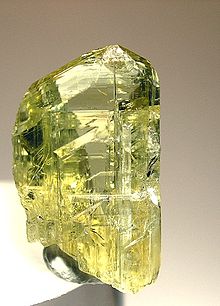Zoisite, first known as saualpite, after its type locality, is a calcium aluminum hydroxy sorosilicate belonging to the epidote group of minerals. Its chemical formula is Ca2Al3(SiO4)(Si2O7)O(OH).
| Zoisite | |
|---|---|
 Yellow zoisite crystal (1.7 × 1 × 0.8 cm) | |
| General | |
| Category | Sorosilicate – epidote group |
| Formula (repeating unit) | Ca2Al3(SiO4)(Si2O7)O(OH) |
| IMA symbol | Zo[1] |
| Strunz classification | 9.BG.10 |
| Dana classification | 58.2.1b.1 |
| Crystal system | Orthorhombic |
| Crystal class | Dipyramidal (mmm) H-M symbol: (2/m 2/m 2/m) |
| Space group | Pnma |
| Identification | |
| Color | White, gray, greenish brown, greenish gray, pink, blue, purple |
| Crystal habit | Prismatic crystals with striations; massive to columnar |
| Cleavage | Perfect {010} imperfect {100} |
| Fracture | Uneven to conchoidal |
| Mohs scale hardness | 6 to 7 |
| Luster | Vitreous, pearly on cleavage surfaces |
| Streak | White or colorless |
| Diaphaneity | Transparent to translucent |
| Specific gravity | 3.10–3.36 |
| Optical properties | biaxial positive |
| Refractive index | nα = 1.696 – 1.700 nβ = 1.696 – 1.702 nγ = 1.702 – 1.718 |
| Birefringence | 0.006–0.018 |
| Pleochroism | X = pale pink to red-violet; Y = nearly colorless to bright pink or deep blue; Z = pale yellow to yellow-green |
| References | [2][3][4] |
| Major varieties | |
| Tanzanite | Gem-quality zoisite, blue-purple |
| Thulite | Pink |
Zoisite occurs as prismatic, orthorhombic (2/m 2/m 2/m) crystals or in massive form, being found in metamorphic and pegmatitic rock. Zoisite may be blue to violet, green, brown, pink, yellow, gray, or colorless. Blue crystals are known under the name tanzanite. It has a vitreous luster and a conchoidal to uneven fracture. When euhedral, zoisite crystals are striated parallel to the principal axis (c-axis). Also parallel to the principal axis is one direction of perfect cleavage. The mineral is between 6 and 7 on the Mohs hardness scale, and its specific gravity ranges from 3.10 to 3.38, depending on the variety. It streaks white and is said to be brittle. Clinozoisite is a more common monoclinic polymorph of Ca2Al3(SiO4)(Si2O7)O(OH). Transparent material is fashioned into gemstones while translucent-to-opaque material is usually carved.
The mineral was described by Abraham Gottlob Werner in 1805. He named it after the Carniolan naturalist Sigmund Zois, who sent him its specimens from Saualpe in Carinthia.[5] Zois realized that this was an unknown mineral when it was brought to him by a mineral dealer, presumed to be Simon Prešern, in 1797.[6]
Sources of zoisite include Tanzania (tanzanite), Kenya (anyolite), Norway (thulite), Switzerland, Austria, India, Pakistan, and the U.S. state of Washington.
See also
editReferences
edit- ^ Warr, L.N. (2021). "IMA–CNMNC approved mineral symbols". Mineralogical Magazine. 85 (3): 291–320. Bibcode:2021MinM...85..291W. doi:10.1180/mgm.2021.43. S2CID 235729616.
- ^ http://rruff.geo.arizona.edu/doclib/hom/zoisite.pdf Handbook of Mineralogy
- ^ http://www.mindat.org/min-4430.html Mindat
- ^ http://webmineral.com/data/Zoisite.shtml Webmineral data
- ^ Flint-Rogers, Austin (1937). Introduction to the Study of Minerals. McGraw-Hill Book Company. p. 478.
- ^ Faninger, Ernest (1988–1989). "Neue Daten über die Entdeckung des Zoisits" [New Data About the Discovery of Zoisite]. Geologija: Razprave in poročila (in German and Slovenian). 31, 32. Državna založba Slovenije [State Publishing House of Slovenia]: 609–615. ISSN 0016-7789.
Bibliography
edit- Hurlbut, Cornelius S.; Klein, Cornelis, 1985, Manual of Mineralogy, 20th ed., ISBN 0-471-80580-7
- Faye, G. H.; Nickel, E. H. (1971). "On the pleochroism of vanadium-bearing zoisite from Tanzania" (PDF). The Canadian Mineralogist. 10: 812–821.
External links
edit- Chisholm, Hugh, ed. (1911). . Encyclopædia Britannica. Vol. 28 (11th ed.). Cambridge University Press. pp. 1000–1001.